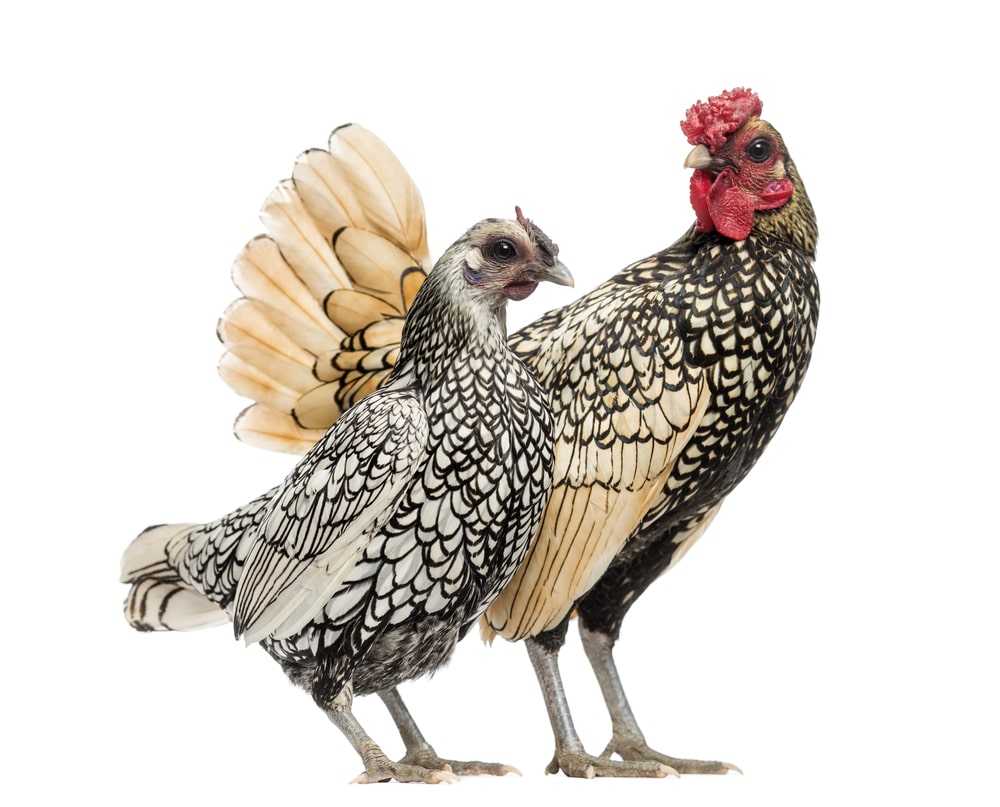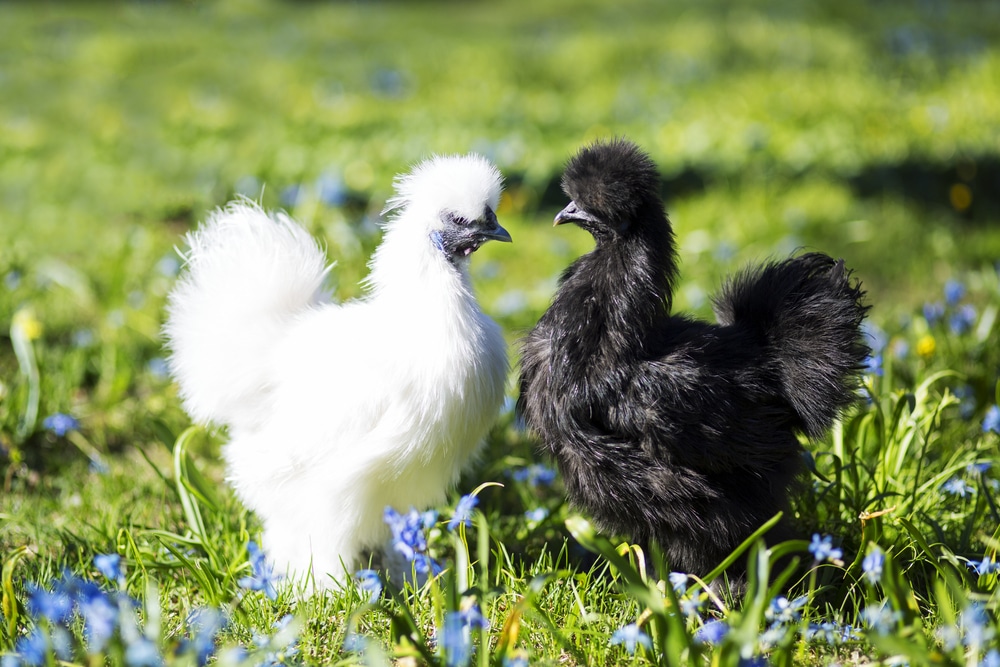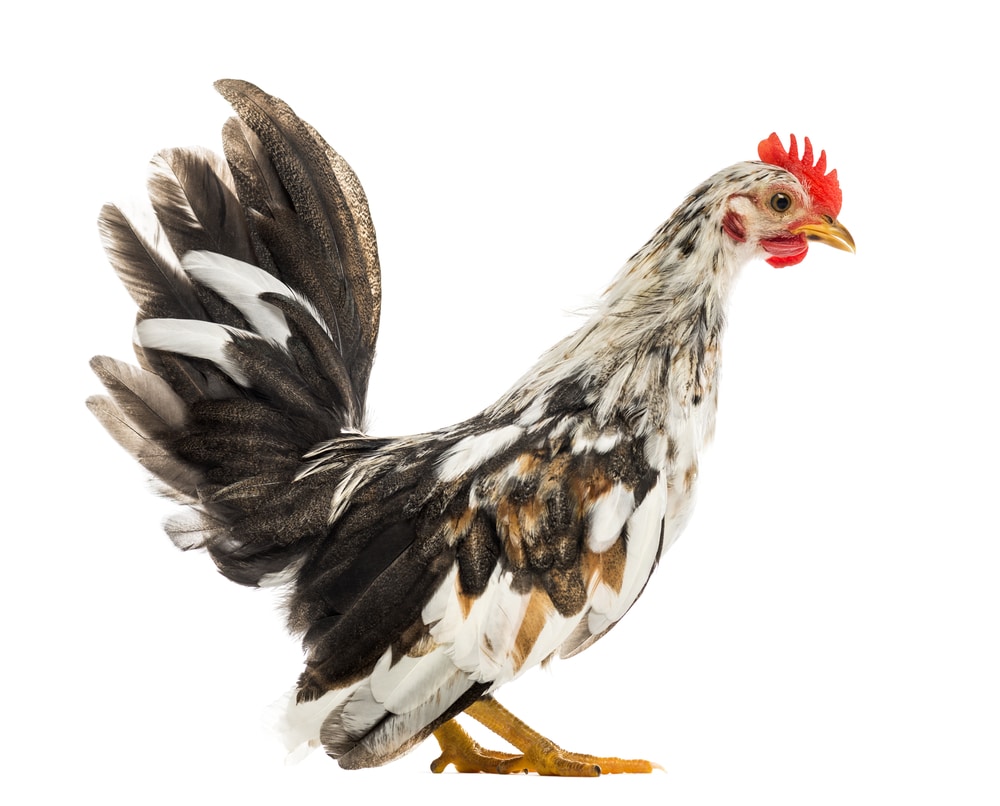The bigger, the better, right?
When it comes to chickens, that might not always be the case.
In fact, bantam chickens are some of the most incredible birds you can raise. Not only are they just as beautiful as their full-sized counterparts, but they’re often easier to manage, too.
What many people don’t realize is that a bantam chicken is not a specific breed, but instead a smaller version of a recognized standard breed. Essentially, they’re miniature chickens.
Why raise bantam chickens? There are plenty of reasons to add these pint-sized birds to your flock. We’ll tell you everything you need to know.
What Are Bantam Chickens?
Bantam chickens are miniature versions of full-size, standard chicken breeds. Most bantams were bred from their larger counterparts, with options including Plymouth Rocks, Brahmas, and even Rhode Island Reds.
However, there are some bantam chickens, frequently referred to as true bantams, that do not have any large counterpart. These ornamental birds were bred hundreds of years ago and include Sebrights, Belgian d’Anver Bantams, Nankins, and many more. They have no large breed counterpart – what you see is what you get.

A third category of bantam chickens is the developed bantam. These birds were small to begin with and were then developed to be even smaller, with common variants including Japanese and Cochin chickens.
There are 63 breeds and 415 varieties of bantams that are formally recognized by the standard. Bantam breeds can be categorized as:
- Single Comb Clean Legged
- Feather Legged
- Rose Comb Clean Legged
- Any Other Comb Clean Legged
- Game (American and Old English)
- Modern Game
There are also bantam ducks.
The word “bantam” is taken from the name of a seaport town in Indonesia called “Bantan.” Here, sailors stopped by for food and water and were astonished by the chickens there. The Bantam chickens were much smaller than the chickens they were familiar with back home.
Benefits of Raising Bantam Chickens
While you might think bigger is better, that’s certainly not the case when raising bantams. These birds offer plenty of advantages to novice and more experienced chicken keepers alike.
Not only do bantam chickens consume less feed, but they’re less expensive to keep and also produce less waste. There’s less of everything, in fact, making bantam chickens a great option for urban environments where you might be tight on space.
Bantam chickens tend to be more docile, too, and even when they aren’t, their small size makes them a good choice for young children. Most have fun, easygoing personalities.
These birds aren’t usually raised for meat, but they can still produce eggs. It takes about one and a half to two bantam eggs to equal a full-sized egg, but otherwise, the two are exactly the same.
Bantam chickens have amusing personalities and are filled with life and vigor. They are great pets and provide plenty of entertainment as they can run faster and fly higher than standard large chickens.
The hens of bantam breeds tend to go broody at some point or another. This is beneficial if you don’t want to deal with an incubator to hatch your own eggs. Plus, bantam hens tend to be great mothers.
Here’s another often unrecognized benefit of raising bantam chickens – they tend to be way quieter than larger chickens. This is especially true of the roosters, whose crows are measured at 60 decibels instead of 90!
Most Popular Bantam Breeds

If you are considering adding bantam chickens to your backyard flock, you might want to consider one of these most popular bantam breeds.
Old English Game Bantam
Game bantams are gamefowl chickens in miniature. There are all kinds available, including black-breasted red fowl. These chickens are beautiful and have close-fitting, glossy feathers that make them appear even smaller than they actually are!
Silkie
When most people think of bantam chickens, they usually think of Silkie chickens. These birds are absolutely gorgeous and are also fantastic around young children.
Silkies are unlike any other chicken breed in that they are covered in fluffy feathers that look more like down. They have a hard time keeping themselves warm in the winter and cool in the summer, but otherwise, they aren’t difficult to raise.
Silkie chickens love to be held and are known for being docile – yes, even the roosters! They don’t lay a ton of eggs – usually only about 100 per year – but the hens are great mothers.
Belgian d’Uccle
Belgian d’Uccle chickens are easiest to identify by their tufts and birds. They are remarkably cuddly and can be found in all kinds of colors, including blue, millefleur, mottled, white, cuckoo, black, and lavender.
These chickens are good layers and produce up to 200 eggs each year.
Cochin Bantam
Cochin Bantams are friendly chickens that lay up to 200 small brown eggs each year. They love being around humans and are incredibly cuddly and intelligent. They have feathered feet and only weigh about two pounds.
Serama
Another true bantam breed is the Serama bantam. This chicken breed is the smallest in the entire world. Native to Malaysia, Serama bantams are most easily identified by the small stature, vertical wings, and puffed-out chest. These chickens lay up to 160 bite-sized eggs each year.
Polish
Polish bantams are friendly, cuddly little chickens that have adorable pom-poms of feathers atop their heads. These chickens love being held, making them great choices if you are interested in ornamental or exhibition chickens. They also lay up to 150 eggs each year.
Dutch Bantam
Dutch bantams are recognized in several different varieties, including lavender, black, partridge, blue, silver, and more. This chicken developed over time as peasant farmers were only allowed to keep small eggs, as the larger eggs belonged to the landowner.
Dutch bantams aren’t usually raised for egg production today, but they are instead raised for their beauty. Often kept as ornamental chickens, Dutch bantams are hardy when it comes to cold weather and other extreme conditions. They can be flighty and lay up to 200 eggs each year.
Sebright
Sebright bantams are beautiful chickens with laced feathers and rose combs. They can also be found in multiple colors, but silver-laced is one of the most popular variations. These chickens are very tiny, with even roosters weighing less than two pounds. A true bantam breed, the Sebright bantam was deveo[d in the United Kingdom.
Sebright roosters are known for being aggressive. These chickens are also somewhat difficult to breed as males have a tendency toward infertility. They lay about 80 eggs per year, so they aren’t top on the list when it comes to production, but they are beautiful none less.
Japanese Bantams
Japanese bantams are some of the most popular bantam chickens. They are easy to keep and have very short, squat legs. They lay roughly 150 eggs each year and can be found in recognized colors like red, lavender, black, and partridge. A frizzle version of this chicken breed is also available.
Cornish Bantam
Cornish bantams were first introduced in 1887 as Indian-Game bantams. These chickens only lay about two eggs per week, and are sometimes raised for meat, too. Despite their small size, they have decent-sized breasts.
Belgian Bantams
Belgian bantams originated in, as you might guess, Belgium. These chickens can be found in all kinds of colors and are considered to be rarer than some of the other breeds on this list. Not only are they friendly, but they are also considered true bantams – they have no full-sized equivalent.
Belgian bantams are great fliers, so you will need to make sure you have a tall fence and a secure coop. This will also keep predators out. Belgian bantams lay up to 150 off-white eggs each year.
Pekin Bantam
Native to China, Pekin bantams are similar to other varieties of bantams in that they have feathered feet. They were one of Queen Victoria’s favorite chicken breeds and are known for their docility.
Although these chickens produce a measly 80 eggs each year, the hens are known for their tendency to go broody. You’ll easily be able to hatch your own chicks!
Wyandotte Bantam
If you want to raise a bantam chicken that will provide a few more eggs for you than average, you might want to consider raising a Wyandotte bantam. These chickens were developed in New York and are some of the most winter-hardy bantam breeds you can raise. They can lay up to 220 eggs each year!
Brahma Bantam
The Brahma bantam, like it’s full-sized counterpart, can be found in light, buff, white, black, and dark color variations. These chickens have feathered feet and were first accepted into the American Poultry standard in 1946. A gentle, easygoing chicken breed, the Brahma Bantam is a fantastic egg layer, producing up to 200 brown eggs each year.
Bantam Chicken Care

If you’re already experienced at raising standard-sized chickens, raising bantam chickens won’t be much different. These birds are smaller, so their metabolisms are higher and they may need to be fed more frequently in order to stay healthy. They won’t eat quite as much as their larger counterparts, though.
Bantam chickens can be raised just about anywhere in which you would raise full-sized chickens, with one exception – they sometimes have a difficult time shaking off the cold. Both Dutch and Japanese bantams do poorly in the cold.
Otherwise, you can keep your bantam chickens warm by ensuring that their housing is draft-proof and dry.
You don’t need quite as much space when you’re raising bantam chickens. While with large chickens, you will need at least four square feet of coop space per bird and eight square feet in the run, bantams only require one to two square feet in the coop and four in the run.
You can set up your coop exactly the same for a bantam chicken as you would for a standard breed. However, you may need to provide lower perches, as their legs might be shorter. This isn’t true of all bantams, though -some like to fly and prefer high perches. Do some research into your bantam breed of choice before you set this up in your coop.
It is possible to raise bantam chickens with full-size birds, too. However, you will want to keep a close eye on the flock dynamics to make sure your little guys aren’t being picked on by the big boys. They tend to be at the bottom end of the pecking order.
In fact, you may want to avoid introducing bantams to established coops of standard-sized birds. Despite their small size, bantams aren’t always aware of their limitations and will be just as bullish as the larger birds. This can get them into some trouble, as you might imagine!
The average bantam chickens will live for around five to seven years, which is about the same as regular chickens.
Health Considerations of Bantam Chickens
While most bantam chickens are just as healthy as their standard counterparts, there are a few exceptions to this. Bantam chickens are more likely to be sablepoots, which means they have feathered feet.
This is an adorable and beautiful feature of a bird to have, but unfortunately, it means that the foot feathers of your birds can easily become crusted-over and soiled if the pen is not free of mud. You will need to keep an eye out for wet areas to help your bantams stay healthy.
If their feet do become wet and dirty, you may need to give them a foot bath. All you need to do is stand the bird in warm water and pull gently at the feathers to release the muck.
These foot feathers can cause other problems, too. For one, the feathers break easily and can cause bleeding when they do. They can also be prone to scaly leg mites, so make sure you check your birds regularly for these sorts of problems.
Can Bantam Chickens Be Raised for Eggs and Meat?
You can easily raise bantam chickens for eggs, but they aren’t the best birds to raise for meat.
Bantam eggs are much smaller than those of their standard counterparts. Otherwise, all other egg production features are exactly team.e in most cases – this depends on the specific type of bantam – your production will be just as consistent as if you were raising standard breeds. They may slow off or shut down in the winter, but this is not a characteristic that is exclusive to bantams.
It’s important to note that bantams who were derived from standard-sized fowl may lay slightly larger eggs on a more regular basis, especially when compared to true bantams. The yolks in bantam eggs seem to be much larger than the albumen, which may mean you need to adjust your recipes.
While the meat of a bantam chicken doesn’t taste much different than the meat of a standard-sized chicken, you aren’t going to get much of it. Therefore, most people don’t raise bantam chickens for this purpose, preferring instead to raise them as pets or for ornamental purposes.
Challenges You should Keep in Mind
There are plenty of benefits to raising bantam chickens but, as with anything, there are some disadvantages, too.
Bantam chickens are great foragers, and they are also quite mobile. They run faster and fly higher than standard breeds. This can be problematic when it comes to the layout of your coop and run, particularly in regards to your fencing. Many bantams can easily fly over a fence that would adequately contain a bird of a larger breed.
This not only makes them more difficult to manage, but also more susceptible to attacks by predators. The roosters won’t do a great job at protecting the flock, nor will they be able to alert you to the presence of an intruder. In most cases, bantam roosters give out little more than a squeak.
While bantam chickens are great if you are short on space or money, they aren’t the most economical choice if you are trying to raise production chickens. This is especially true if you are limited to six or fewer chickens by the municipality in which you live. Six chickens are plenty for most people when it comes to egg production, but six bantam chickens will not be as productive.
A final word of caution when raising bantam chickens? Although they are usually much easier to handle, they are so small that you have to be worried about stepping on them. They aren’t as forgiving of the cold, either, so you’ll need to pay attention to the conditions in which you are raising them.
Some hatcheries also do not sell sexed bantam chicks. Therefore, you will have to purchase them straight-run.
Are Bantam Chickens Right for Me?
Bantam chickens are typically kept for ornamental or exhibition purposes, and they’re often chosen as pets. However, they probably aren’t the best choice if you want a high-production chicken that will lay lots of eggs or produce tons of meat for you.
If you don’t necessarily care about the eggs and meat, then a bantam chicken could be a perfect choice. It is economical to keep, so you’ll be able to save a bit of money as you are learning the ropes of raising backyard chickens, too.
